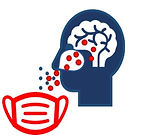Face masks and PFAS
TW research 2022
The aim of the ToxicoWatch Foundation is to raise public awareness about exposure to toxic chemicals in everyday life. Therefore, TW started the initiative to set up this pilot study on face masks based on questions:
-
Is PFAS added to face masks?
-
What are the risks for human health if PFAS is added to face masks?
This research focuses on PFAS and its many pathways into the human body via the skin, respiratory tract, mouth, lungs, eyes, nose, and the blood-brain barrier. TW initially based this research on three types of single-use face mask samples (FFP2, medical), complemented with a literature study on PFAS, toxic chemicals and textiles.
An increasing number of studies show a relationship between emerging diseases and PFAS.
From the precautionary principle point of view, highly persistent and toxic substance as PFAS in (medical) textiles - meant to protect our health – will be discussed in this report.
Silent PFAS pandemic

The widespread use of undegradable PFAS chemicals in many products is a danger to our health and environment, writes independent toxicologist Abel Arkenbout. We must act now to stop their widespread use.
Poly- and perfluoroalkyl substances (PFAS) are referred to as “forever chemicals”. Once made, these substances are indestructible and can remain in the body for a lifetime. The extremely strong fluorocarbon bond is the reason the molecules cannot be broken. No bacteria are interested in digesting this particular type of molecule.
Also, waste incinerators have difficulty destroying PFAS, even at high temperatures of 850 degrees Celsius. PFAS are now also found in soil, compost, water, the human body, and even in the brain.
PFAS possess unique properties to repel water, oil and dirt and are highly wear-resistant. This is why they are incorporated in all sorts of products. Examples include water-repellent clothing, waterproof make-up, paper food packaging (pizza boxes, fast food), cardboard coffee cups, electronics, baking paper, dental floss, solar panels, wind turbines, and so on. In addition, PFAS are used in fighting against complex fires (AFFF).
Although much research has been done in the past decades on the relationship of PFAS with a variety of diseases, immunity and neurodegenerative disorders, there is still much uncertainty about the effects of PFAS. This is partly because the chemical industry releases new PFAS compounds almost every day. PFAS compounds are additionally difficult to analyse in a laboratory. Nevertheless, the results that do emerge are alarming.
Chemical industry advocates, such as Theo Richel of the Green Court of Auditors (de Groene Rekenkamer), make several arguments about why we should not worry about PFAS. The dose makes the poison, it is said, and PFAS involves only very small amounts. But the action of PFAS is different from many other toxic substances, we know from new, highly sensitive analytical methods. With PFAS, there is no linear dose-response relationship because the substances act through hormonal receptors. PFAS, therefore, appears to be extremely toxic even at very small concentrations.
A second argument is that there would be no difference between natural and synthetic (man-made) toxins. According to Richel, we ingest much more from natural pesticides - created by plants to defend themselves against natural enemies - than synthetic ones. This is of a different order; natural toxins are degradable. Richel relies on a 1991 source (Ames), which claims that broccoli is a thousand times more harmful than dioxin. Fortunately, this claim is based on a misinterpretation of molecular binding to a particular receptor on the cell membrane. Receptors are the attachment points of foreign substances such as dioxins and PFAS. The major difference with natural substances is their persistence; they cannot be degraded in the body. Activation of such a receptor does not mean it will also give you cancer. Substances that prevent cancer also work through this receptor. The development of cancer, carcinogenesis, is a complicated process. Substances in broccoli actually protect against cancer development.
Richel also claims that oranges would contain all kinds of natural 'carcinogens'. This is incorrect. What is not mentioned, and is important to mention, is the chemical addition of Chlorpyrifos when oranges are grown. This extremely dangerous pesticide is banned in the Netherlands but re-enters our country via Belgium. Research shows that this substance has been linked to neurotoxic damage to children's developing brains.
Then there is the argument that our life expectancy has steadily increased (although that has stopped since 'the corona'), which would show that the danger of PFAS and other substances is not all that bad. More important than life expectancy is the quality of life. Neurotoxicity is increasingly common at younger ages (Alzheimer's, Parkinson's). Today, one in six children suffers from some kind of neurodevelopmental disorder (ADHD, autism). These rates have risen alarmingly in recent decades.
Richel refers to the American Council on Science and Health (ACSH), which concludes, based on the scientific literature, that PFAS would be completely harmless. However, the ACSH is a dubious source. This organisation is extremely negative about the critical attitude towards vaccination, genetically modified food (GMO), pesticides (glyphosate) and PFAS in Europe. This continent is portrayed as backward with stupid people, sunk deep into the dark Middle Ages. Americans are much more intelligent, and the scientific work of European scientists and the European Food and Consumer Safety Authority (EFSA) is just short of being dismissed as 'fake news'. Well-known advocates of the precautionary principle, such as Danish environmental epidemiologist Professor Philippe Grandjean and renowned American researcher Rachel Carson (Silent Spring, 1962), who revealed the dangers of DDT to a wide audience, are attacked ad hominem on the ACSH website.
Immune and neurotoxic damage for PFAS has been established, precisely not based on tests on rats and mice, but on the basis of epidemiological research, which rings alarm bells. In his work, Grandjean calls PFAS a chemical 'brain drain'. Researchers have shown that brain development is affected by chemicals, which affect our moods, joy/well-being/depression. When chemicals affect a child's brain, it is at risk of mental retardation or cerebral palsy. With PFAS, there is delayed toxicity, which translates into a dormant decline in brain activity, a lowering of IQ, endocrine disruption and undermining of the immune system. These are gradual processes that are not immediately visible but do pose a real risk.
It is not for nothing that the Netherlands has joined Denmark, Germany, Sweden, and Norway in proposing a European ban on PFAS. This would ban the use of all poly- and perfluoroalkyl substances as a group, according to RIVM, "the largest substance ban ever in Europe". There are standards for PFOA and PFOS dating back to 2008 and 2020. A problem in setting and enforcing PFAS standards is the extremely difficult contact with the industry. For instance, it is difficult to get reference material for PFAS, while it is obviously available. Partly because of this, research into setting safe guide values for PFAS in drinking water and food is limited to only 4 perfluoroalkyl substances (EFSA-4 PFAS). This while thousands of PFAS have not been investigated in laboratories but have been made by industry.
Industry wants to ban only those substances that are 100% certain to be harmful. It would be much better to introduce new substances only when their safety has been demonstrated, but also in the longer term. So not just when the poor mouse or rat dies in a laboratory within an hour. The only way to limit the damage is to stop all risky PFAS production.









